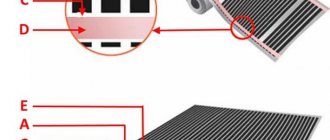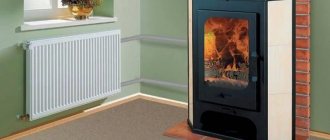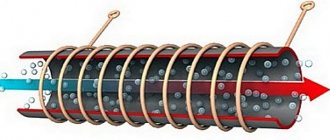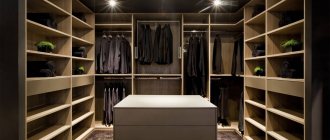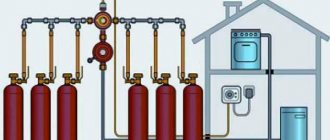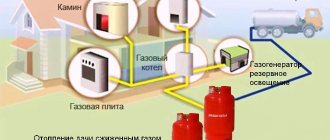Principle of operation
Our Sun emits infrared waves in different spectrums - near, middle and far. Radiation with a wavelength of 8–14 microns is considered the most effective and safe. It is used in the production of equipment for infrared heating at home. Essentially, these heaters are a small sun that runs on electricity. Unlike conventional radiators (oil or electric), they do not heat the air - the radiation only heats the objects it hits, and these same objects become a source of heat. It is from them that the air in the room is heated, so the surfaces in the equipment operating area are always warmer than in other areas of the room.
Impact on humans
Like any other radiation, infrared waves can be harmful to health. The degree of influence depends on the wavelength. Short-wave “luminous” heaters with a wavelength of up to 3 microns provide quick heating of open areas of the floor and surfaces of objects, but can lead to overheating of the upper layers of the skin, drying it out and even burns. Such emitters are used in solariums.
The most comfortable for humans are heaters with an operating wavelength of more than 7 microns. Such waves penetrate deeper into the body, but do not have a burning effect and are not harmful to health.
pros
When compared with traditional heating methods using convectors and oil radiators, the infrared panels in question have a number of advantages:
- Fast heating. When the equipment is turned on, the temperature in the area of its operation rises after 1–2 minutes. This is due to the fact that the rays are not scattered in the air, but reach their direct destination with little loss.
- Quiet operation and environmental friendliness - the operation of the equipment does not produce any sounds or vibrations. During the heating process, no harmful substances are released that could harm residents. Also, film infrared heating dries the air to a lesser extent, since heating occurs not from the hot surfaces of the radiator, but from warm pieces of furniture, walls, and floors.
- Wide application - these systems can be used not only in the home, but also in industrial premises, garages, utility rooms, and on the street.
- Effective air heating. Conventional radiators heat air, which rises, cools and falls down. As a result, the temperature at the feet is always lower than at the ceiling, which is not entirely correct. Infrared heaters direct rays from top to bottom, as a result of which the floor and pieces of furniture below are heated - heat emanates from them, so the air temperature below will be approximately equal to the temperature above. Also, convection currents (air circulation) are noticeably weaker.
- Unlike conventional electric convectors, infrared systems do not burn oxygen and do not dry out the air.
We can talk for a long time about the advantages of these systems.
Heating system design
As with any other electric heater, the main part of an infrared heater is the heating element: halogen, carbon, ceramic or tubular. The body can be metal, ceramic or a combination of metal and plastic.
Depending on the type, IR heaters are available with reflectors or heating panels. In the first version, the heating element is covered only by a protective grille, and the reflector (reflector) not only enhances infrared radiation, but also localizes the heating zone; in the second, the heating element is covered with a blank panel. Depending on the brand and price category, the heaters have mechanical or electronic controls (with a timer); the electronics can be controlled from the remote control. But even budget models are equipped with protection against overheating, moisture and tipping over (floor-standing).
To minimize energy costs, thermostats are connected to the heaters to regulate the operating mode.
The power of the devices starts from 300 W and varies over a wide range (there are units of 2 kW and more), but, as with convectors, our craftsmen advise covering the area with several devices of lower power. Marketers claim amazing savings and minimal electricity consumption, but no one has repealed physical laws. To generate a certain amount of heat, the device must spend a certain amount of energy, and in this case there is nothing unexpected - 1 kW per 10 m² of area, if everything is difficult with insulation in the house, then it’s worth throwing a little on top.
Another thing is that in a well-insulated room, where heat does not escape through the walls, floor and ceiling, the windows and doors are sealed, and ventilation is not due to drafts, the heaters will reach the set mode faster, and less electricity will be required to maintain it. And since the principle of operation is such that surfaces are heated not by air, but by radiation, as a result, electricity costs may be slightly lower than when heating with convectors or other electric heaters. But again, everything is purely individual.
Versatility, health benefits, safety
Nobody bothers you to combine infrared heating batteries with conventional radiators - they can complement each other. With minimal effort, you can create a “warm island” in your home by installing 2-3 simple heaters, which will be directed to the kitchen corner, for example, or to the sofa. They are often installed in gazebos on the streets or in verandas. This will allow you to sit outdoors even in relatively cold weather.
Installation of infrared heaters is extremely simple - they can be placed on a special leg, hung on a wall or attached to the ceiling. They plug into an outlet and are immediately ready to use.
It is believed that infrared heating systems are more beneficial for human health. The sun's rays, when they hit a person's skin, penetrate inside and heat the blood vessels, causing heat to quickly spread throughout the body. However, there are often disputes that infrared heaters are harmful to health, which is not true. According to research by Japanese scientists, these devices serve as a preventive measure against many diseases.
Monthly costs of infrared heating
When using any heating system, you have to pay for its operation every month, whether it is gas, electricity, wood or liquid fuel.
A warm ceiling consumes from 10 to 20 W per hour per 1 m² of heated room area. For example, consider a house with an area of 100 m².
100 m² * 15 W (take the average value) * 24 hours a day * 30 days/1000 (1 kW = 1000 W) = 1080 kW per month.
Let's convert the received calculations into a monetary equivalent, for the cost of kW we take electricity tariffs for the population living in Tyumen and urban settlements of the Tyumen region in houses equipped in the prescribed manner with electric stoves and (or) electric heating devices, a single-rate tariff for electricity is 1 .81 rub.
1080*1.81=1954 rub.
Heating costs for such a house are only about 2,000 rubles. per month! Agree, this is not at all a lot for heating such a house.
Minuses
This equipment has not only positive qualities. There are also disadvantages:
- Spot action of the heater. If it works in one place, then the heat will be there; in other parts of the room the temperature is lower.
- Taking into account the fact that the rays of the heater pass through the air and warm the furniture and things that they fall on, it is possible that a plastic smell may appear. This is possible if the heater is directed at the chair on which the TV remote control is lying.
- Aesthetics suffer in some cases. Portable or even film heaters do not always fit aesthetically into the interior.
- High price of the equipment itself.
Considering how much an infrared heater consumes (depending on the power, consumption reaches 0.5–1.5 kWh or 50–200 Wh/m²), it cannot be called energy efficient. In terms of energy consumption, these devices are almost no different from conventional oil radiators or convectors. Efficiency can be achieved by insulating the room and installing heat-reflecting screens, but this is also possible with conventional radiators.
Radiation intensity
When choosing infrared heating, you need to be careful with the power of the device. Normally, it should not exceed 350 W per square meter. If the radiating element is not heated above 100°C, then the surface of the heated objects will not be above 35°C. Properly designed and installed IR heaters can distribute heat evenly throughout the home, creating a comfortable microclimate.
Powerful infrared heating over a long period of time is dangerous for the skin and eyes. But household IR devices are adapted and the spectrum is configured for human use in residential conditions.
Varieties
There are three types of infrared heaters: film, panel, stationary. There are design features between them. Stationary ones are the simplest. These are separate devices that are installed on a leg (or attached to the wall) and plugged into a free outlet. They can be directed to the sofa, and then moved and plugged into another outlet.
Film and panel ones are not mobile. The latter can be installed in the ceiling or on the wall, while film ones can be installed on the ceiling or floor. Each type has its own characteristics.
Panel
When organizing infrared heating of a private house or apartment, panels are more often used, and films are less often used. Flat panel equipment allows you to save room space, as it does not involve changing the height of the room. This is a relevant solution for rooms with low walls.
They consist of:
- Heating element - heating element. It is made from one of three materials: quartz, ceramics, tungsten.
- A special panel that receives heat and transfers it to objects in the room.
- Insulation on the back side. It reflects heat waves from the back of the device and eliminates heat loss.
- Cases.
Infrared panels can be built into the ceiling or hung. Built-in ones are more popular and aesthetically pleasing. In this case we are talking about infrared plasterboard heating with special thermal insulation and graphite thread. They are also built into the walls around the perimeter of the room. Each panel has an average power of 150–200 W.
Film
This type of heater is ideal for organizing a warm corner somewhere on a loggia or veranda. It is used for zonal heating, although no one bothers to cover the apartment with “warm films” over the entire area.
In film infrared heating, the main material is a thin layer of graphite, which is applied to a thermoplastic film. Instead of graphite, a carbon thread can be used - when heated, it creates a heat flow. Note that film heaters create a single integral system, but it consists of separate modules. If some section fails, it is not difficult to replace it with a new one without compromising its integrity.
These panels do not have high power, so their efficiency is low. For this reason, they are used for local heating and are rarely installed along the entire perimeter of the apartment.
Types of IR heating
Ceiling option
Both infrared film and panels can be mounted on the ceiling of a residential building as a heating element. In the second case, installation is recommended with a ceiling height of at least 3.5 m: the heat they emit can cause discomfort (for example, if it hits the head) and takes up space. On the other hand, the panels can easily be dismantled and reinstalled in another room or taken with you when moving.
For a typical home, where the ceiling height is in the range from 2.7 to 3.2 m, an ergonomic solution is low-temperature infrared film, the beam flow of which is safe for residents. The heating element in such equipment is aluminum foil, which has the properties of a resistive screen.
Built-in temperature sensors in the ceiling system will allow you to save energy and maintain comfortable thermal conditions. The principle of their operation is simple: when the required temperature is reached, they will signal the system to turn off. Heating will start when the sensor signals a decrease in heat below a preset level.
Gas infrared heating
It is an integration of gas equipment and thermal energy of infrared radiation. The heating system consists of a mixing chamber and a ceramic plate. Gas and air are mixed in a chamber and then heated in a plate, which emits an infrared heat flow.
Gas infrared heating helps to quickly increase the temperature in the room, which provides significant superiority in severe frosts.
Heating with IR heaters
An infrared heater uses a tubular or spiral heating element. The standard model is a rectangular device with a metal body coated with heat-resistant enamel. In addition to the heating element, the heater contains a thermal insulator, a protective screen, fasteners, and power indicators.
The Russian market of infrared heating devices has a wide range. Today there are various color options; you can choose a model that suits the size, shape, weight and, of course, price.
IR devices are used for full-scale and local (spot) heating of a room. This is very convenient when you need to create comfort and warmth in open spaces of the house: on the terrace, in the workshop or in the storage room.
Danger of use and harm
People who choose a heating system want to know whether infrared heaters are harmful. If a person falls asleep on the beach, he can “burn” his skin, his temperature will rise, and even a serious burn is possible. The same is true with infrared heaters - if the panel or mobile equipment is directed at the sofa, then dozing on this sofa is dangerous to health (a person may overheat).
The biggest harm of infrared heating is drying out the skin. With prolonged contact of the skin with infrared rays, the moisture on the human body evaporates, and its replenishment is not carried out immediately. In extremely rare cases, this can lead to a burn (sleeping with the heater on), but more often than not, people’s skin simply dries out.
There is also information that infrared waves somehow affect the protein contained in the skin, and with prolonged exposure, such a heater harms the eyes: first of all, the retina suffers, and secondly, the lens. Sometimes the appearance and development of cataracts in people is associated with infrared heating, although all this has not been proven and is hardly true. Such damage can only be caused when the heater power is very high and a person remains under the waves for a long time.
Rules for laying the heater
There are certain rules that must be followed when working with this device; before installation, the following operations should be carried out:
- prepare the surface for laying IR film. There should be no debris, uneven surfaces, etc. on it;
- when laying the film heater, do not allow overlap;
- exposed wires must be insulated.
After installing the infrared film, the floor can be covered with any floor covering.
Connection
It’s not hard to figure out how to connect an infrared heater - it operates on a 220-230 V network, so the simplest and most obvious way is to plug it into an outlet. At least, mobile models are connected to sockets.
Panels or film systems are connected to each other in parallel, then connected to the thermostat (control panel), after which the wire (phase, neutral and ground) is pulled directly to the machine located in the distribution panel. This allows you to bypass all the wiring brought into the apartment or house. Most often, a separate automatic machine is installed to heat the apartment, which is triggered when there is a heavy load or a short circuit. The rest of the wiring in the apartment is connected to another machine. This allows you to correctly distribute the loads generated during the operation of infrared heaters. If you “hang” a powerful heating system on the existing apartment wiring, then when the heating system and, for example, an electric oven, air conditioner or iron are operating simultaneously, overloads are possible. In rare cases, this leads to a fire, although most often automatic devices are triggered.
However, to create a cozy warm corner with a small number of panels with a total power of up to 2 kW, it is possible to connect an infrared heater to an outlet, that is, the general electrical wiring in the house.
conclusions
We looked at the options and prices for heating a country house. The cheapest types of fuel are gas and coal. It is possible to connect to a free geothermal heat source, but the cost of installation is not yet affordable for most consumers.
In any case, when planning a home heating system, take into account the availability of energy sources and choose the best option
Take the time to do careful calculations and consult with heating experts. Their professional opinion will help you make the right choice.
Most owners of private houses are accustomed to gas heating from a boiler, which is considered the most economical and affordable. However, what about those where it is not possible to install such a heating system? An excellent alternative option is PLEN heating. Specifications, prices and reviews vary between models. We will analyze all the features and independent installation of such a “warm film”.
Installation option in a wooden house
Best models
Various manufacturers in Europe and Russia produce home heating equipment. In this rating of infrared heaters, the best models that have collected positive customer reviews are selected.
1st place - Ballu BIH-AP4-0.8-W
The cost of this model is around 3000 rubles. This heater is designed to heat an area of 16 square meters, connects to a 220/230 V system and is installed at a recommended height of 2.4–3.5 meters, its power is 800 W.
Based on reviews, we find out that this is an effective and high-quality model that warms up the room quickly enough. The set includes durable brackets - with their help the device can be rotated. This model is mainly used as an additional source of heating in any room, but is also suitable for a garage and for installation outdoors - the waterproof housing will not allow rain to spoil it.
2nd place - Almac IK5
This infrared heating battery has a lower power of 500 W. It effectively heats 10 square meters, so in a single copy it is used as an additional heat source. However, three similar models can easily cope with heating a large living room or hall.
Judging by the reviews, the device effectively copes with its task, is easily attached to the wall or suspended from the ceiling, and is simply adjustable - it is enough to set 23 degrees during the day, 20 at night. The only drawback is the complexity of the connection. And although the instructions indicate how to install an infrared heater, the kit does not include wires and a thermostat, so without the appropriate knowledge and experience you cannot connect it - you will have to call a specialist, but you can turn a blind eye to this, given the low price of around 2,500 rubles.
3rd place - Peony Thermo Glass P-10 (7000 rubles)
The model is from the Russian one, which has become popular on the Russian market. Power – 1000 W, heating area – 20 m². The device is connected via a regular 220/230 V socket and is equipped with electronic control and a thermostat, which allows you to accurately regulate the power and heating temperature. It also received protection against overheating, which ensures minimal safety and increases its service life. The infrared heater can be installed on the ceiling at a height of 2.3–3.5 meters.
According to reviews, the model is effective: it quickly heats surrounding objects, operates silently and provides soft and pleasant warmth. This is an advantage, since some models heat aggressively.
The disadvantage is the equipment and high price. The model is significantly more expensive than similar heaters, and the kit does not include any cables. The device also needs to be looked after - if you do not systematically wipe the dust off it, then over time a burning smell will appear.
There are also many low-quality products on the market with the CE mark. In one case it means “Conformite Europeenne”, in the other it means “China Export”. Try to choose reliable equipment, since heating devices in the house always pose a certain danger.
PLEN heating technical characteristics, price, advantages and disadvantages
Infrared warm ceiling, the price of which varies, has its own technical characteristics, which can be collected in one summary table below.
| Parameter | Manufacturers' declared data |
| Material of manufacture | Special alloy for the heating element, and the insulation is made of three-layer PET. Aluminum acts as a reflector. |
| Weight 1 m² | 550 g |
| Thickness | 0.4 mm |
| Highest heating temperature | 45 ⁰С |
| Power consumption | 150 or 175 W per m² |
| Efficiency | About 98% |
| Lifetime | At least 50 years |
In addition to the general values, there may be differences in power density from 100 to 150 W/m². This option should be selected based on the ceiling height.
PLEN is also applicable for heating greenhouses in winter, but is mounted differently
So, at a height of up to 3 m, a power of 125 W/m² is applicable, and from 3 to 4.5 m it is necessary to buy a film with a rating of 150 W/m². When choosing this parameter, this parameter is influenced not only by the ceilings, but also by the average negative temperature. The lower it is, the more heating power is needed.
Advantages and disadvantages
Quite often in private homes you can find infrared heating, reviews of which are positive, because the rays are reminiscent of the sun in the way they release heat. In addition, many other advantages can be highlighted:
- Dimensions. Only a film with a small thickness is mounted on the ceiling, so the entire heating system, to which it remains to add wires, does not take up much space. It is not necessary to attach the PLEN to the ceiling; any surface can be used.
- Installation. The heating system using “warm film” is easy to install, so every consumer who knows how to handle tools can install it themselves. Since the material is lightweight, you don’t need to involve assistants. Typically, work with a ceiling surface of 70-80 square meters takes 2-3 days.
Heating options using PLEN (schematically)
- Low irrationality. You can easily change the temperature in a separate room by setting the necessary parameters.
- Safety. From a fire protection system perspective, PLEN heating is the safest. Maximum heating is only up to 45 ⁰C, which cannot lead to fire.
Thanks to these advantages, you can increasingly find infrared heating using film in private homes, but this option cannot be called cheap. The material itself will require financial investments, and the price of electricity is constantly rising. In addition, the disadvantages, according to consumer reviews of infrared heating using film, include:
Difficulties with finishing. Information from manufacturers states that the film can be hidden under any finish that does not contain metallic inclusions. But, for example, they covered the PLEN with clapboard and got a multilayer device through which it is difficult for IR to penetrate, thereby the heat level drops. It turns out that you need to install a warm ceiling, not a floor. Therefore, it is worth considering the thermal resistance of various coatings. It is best to use through structures with a coating of no more than 50% that transmit thermal rays.
Ceiling finishing option using infrared heating
Design. An uncovered film will heat the room best, but in appearance such a room will look like a warehouse.
It turns out that although the film is easier to install, closing or decorating it is much more difficult than ordinary pipes with batteries.
Price
Having considered the technical characteristics of PLEN heating, we present the prices for some options in the table below, so that you have something to focus on when planning to heat a private home.
| Name | Image | Film characteristics | Price per 1 m², rub. |
| “Zebra” EVO-300PRO – 0.6x0.5 | Heater size | 600 by 500 mm | 360 |
| Thickness | Not less than 1 mm | ||
| Current frequency | 50 Hz | ||
| Power | 66 W | ||
| “Zebra” EVO-300PRO – 4.2x0.5 | Heater size | 4.2 by 0.5 cm | 2500 |
| Thickness | Not less than 1 mm | ||
| Current frequency | 50 Hz | ||
| Degree of protection | IP 44 | ||
| Heating film TM 0.5 x 1.25 | Heater size | 0.5 by 1.25 m | 440 |
| Thickness | 0.34 mm | ||
| Current frequency | 50 Hz | ||
| Degree of protection | IP 44 | ||
| Guarantee | 10 years |
In different cities there are various companies offering turnkey installation and sale of IR film heating.
Related article:
Features of arranging transparent walls
The arrangement of transparent walls that decorate the exclusive interior of the room is accompanied by taking into account a number of important nuances.
- A lot of thermal energy is lost through large window structures, changing the microclimate of the room.
- The difference in parameters of external and internal temperatures forms the air space where cooled flows move.
- In winter, frosty patterns appear, rising temperatures condense vapors, which, after flowing down, become an excellent habitat for harmful fungi.
Preserving the aesthetic appeal of the panoramic glazing design is achieved by assembling a special heating system.
Bimetallic devices for panoramic windows
This type of radiator belongs to heat supply equipment, the high cost of which best corresponds to the quality.
Bimetallic radiators differ:
- High working pressure.
- Compatible with other metals. In them, aluminum is used only for the manufacture of the shell, which increases the aesthetics of appearance and heat transfer. As for the internal casing, equipped with outlets for connection to the system, it is made of stainless steel or black steel.
The height of bimetallic radiators for panoramic windows ranges from 24.5 to 45 centimeters.
Low radiators
A worthy replacement for standard radiators will be their low variety - they are in no way inferior in quality, but at the same time they do not visually burden the interior at all and leave a fairly wide viewing angle.
They can be installed directly in front of double-glazed windows: they protect against condensation and drafts. It is very important to choose the model that will be ideal for your home. For example, cast iron batteries take a long time to heat up, but at the same time they hold high temperatures very well and on average last up to 50 years
Steel and aluminum heat up faster, but at the same time they do not please with their strength. Bimetallic models can be considered the best option - they combine both good heating and high strength.
